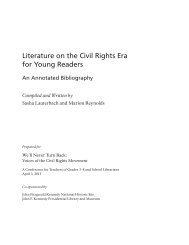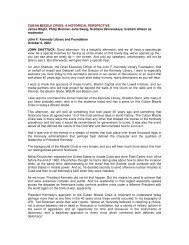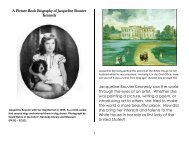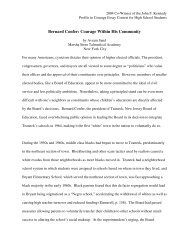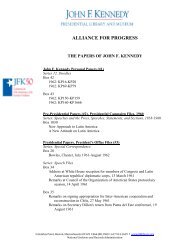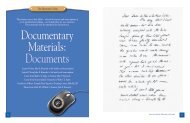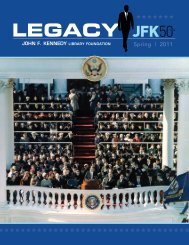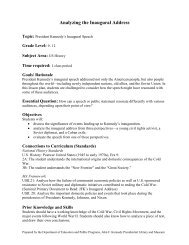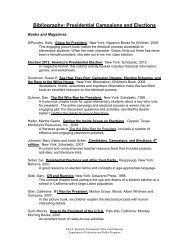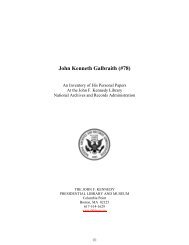1 hemingway's library - John F. Kennedy Library and Museum
1 hemingway's library - John F. Kennedy Library and Museum
1 hemingway's library - John F. Kennedy Library and Museum
Create successful ePaper yourself
Turn your PDF publications into a flip-book with our unique Google optimized e-Paper software.
the 1930's:<br />
He wanted to know everything. Didn't make any difference what it was. He wanted to know how the<br />
fisherman cut the bait <strong>and</strong> everything. He was greatly interested in everything that went on.... He was<br />
terrifically curious about everything. Gregory once said that if someone committed the perfect murder,<br />
Papa would have a fit until he found out how he did it.(49)<br />
Mary Hemingway says much the same thing: "Ernest's interests were wide-spread, encyclopedic.... He was<br />
indefatigable in his search for information of every sort."(50) It is in this context that the following description by<br />
Lloyd Arnold should be seen: "He'd gone to sleep on my Idaho Encyclopedia <strong>and</strong> had been absorbing it since first<br />
light. 'A hell of a lot of state, this Idaho, that I didn't know about."' (51) It is not surprising, therefore, that the<br />
composite record reveals that Hemingway owned vast numbers of nonfiction books on many subjects. In a letter to<br />
Bernard Berenson in answer to his friend's queries, Hemingway wrote that he liked best true books about campaigns<br />
<strong>and</strong> voyages. Undoubtedly, the Homeric allusion was not lost on Berenson. Hemingway went on to write that he<br />
liked novels <strong>and</strong> continued to read new ones, hopefully, but found most of them worthless. In addition, he added, he<br />
liked to read technical books, biographies <strong>and</strong> memoirs. (52) This is a good, brief description of the basic contents<br />
of Hemingway's <strong>library</strong>. However, as he did in the case of the description of his periodical reading, Hemingway<br />
understated to Berenson the range of topics covered by the nonfiction works in his <strong>library</strong>, which includes matters as<br />
diverse as criminal investigation, taxidermy <strong>and</strong> Italian Renaissance painting. In 1945, writing to Malcolm Cowley<br />
about his self-education, Hemingway summed up his continuing effort to learn about the world. He told Cowley that<br />
he continued to study <strong>and</strong> to read. Every year he studied something new in order to keep learning. Learning, he<br />
went on, was fun, <strong>and</strong> he didn't see why he couldn't keep it up all his life. (53) It was this passion for information<br />
that Hemingway admired in Tolstoy. It was not experience that excited Hemingway, but knowledge. He wanted to<br />
know. His novels had to be supported by knowledge.<br />
C. Literary Pronouncements<br />
Hemingway's letters contain many comments on his reading <strong>and</strong> on literature in general, but most of these<br />
are naturally topical <strong>and</strong> very limited in their scope. Occasionally, however, Hemingway made larger<br />
pronouncements on literature in an attempt to articulate his sense of literary context <strong>and</strong> to acknowledge the writers<br />
who he felt had most influenced him. Typically, these pronouncements took the form of lists of books or authors.<br />
Sometimes they were explicitly presented as guides for young writers. More often they were simply lists of what he<br />
considered the high points of literature or of works that he felt had been particularly important to him. These lists<br />
provide some general insight into the books that Hemingway considered the core of his <strong>library</strong>, <strong>and</strong> a brief discussion<br />
of them will add an important dimension to the topic under consideration.(54)<br />
Hemingway's most famous pronouncement on literature occurs in Green Hills of Africa, where, as he later<br />
told George Plimpton, "I was sounding off about American literature with a humorless Austrian character.... I wrote<br />
an accurate account of the conversation. Not to make deathless pronouncements. A fair per cent of the<br />
pronouncements are good enough.(55) What Hemingway tells the humorless Austrian is this: "The good writers are<br />
Henry James, Stephen Crane <strong>and</strong> Mark Twain. That's not the order they're good in. There is no order for good<br />
writers."(56) Hemingway's relation to James will be discussed in Part II. In the case of Crane, two stories are singled<br />
out: "The Open Boat" <strong>and</strong> "The Blue Hotel." However, it is Clemens who receives the greatest praise: "All modern<br />
American literature comes from one book by Mark Twain called Huckleberry Finn.... All American writing comes<br />
from that. There was nothing before. There has been nothing as good since."(57) Even when allowing for<br />
hyperbole <strong>and</strong> the dramatic context the statement does not conflict with other pronouncements he made about the<br />
same time.<br />
Hemingway finished Green Hills of Africa in the fall of 1934. In 1935 he published two articles in Esquire<br />
that contain lists of books that place his comments on American literature in a larger context. The first list appeared<br />
in "Remembering Shooting-Flying: A Key West Letter" <strong>and</strong> is cast in hyperbolic manner similar to that of the<br />
pronouncement in Green Hills of Africa:<br />
... I would rather read again for the first time Anna Karenina, Far Away <strong>and</strong> Long Ago, Buddenbrooks,<br />
Wuthering Heights, Madame Bovary, War <strong>and</strong> Peace, A Sportsman's Sketches, The Brothers Karamazov,<br />
15



